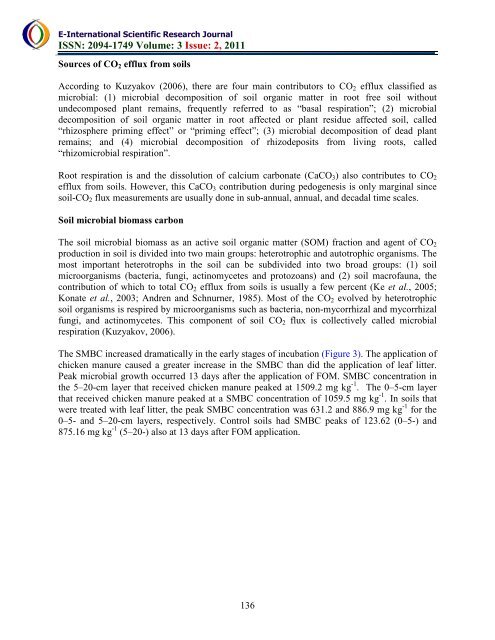download the full article here - E-International Scientific Research ...
download the full article here - E-International Scientific Research ...
download the full article here - E-International Scientific Research ...
You also want an ePaper? Increase the reach of your titles
YUMPU automatically turns print PDFs into web optimized ePapers that Google loves.
E-<strong>International</strong> <strong>Scientific</strong> <strong>Research</strong> Journal<br />
ISSN: 2094-1749 Volume: 3 Issue: 2, 2011<br />
Sources of CO 2 efflux from soils<br />
According to Kuzyakov (2006), <strong>the</strong>re are four main contributors to CO 2 efflux classified as<br />
microbial: (1) microbial decomposition of soil organic matter in root free soil without<br />
undecomposed plant remains, frequently referred to as “basal respiration”; (2) microbial<br />
decomposition of soil organic matter in root affected or plant residue affected soil, called<br />
“rhizosp<strong>here</strong> priming effect” or “priming effect”; (3) microbial decomposition of dead plant<br />
remains; and (4) microbial decomposition of rhizodeposits from living roots, called<br />
“rhizomicrobial respiration”.<br />
Root respiration is and <strong>the</strong> dissolution of calcium carbonate (CaCO 3 ) also contributes to CO 2<br />
efflux from soils. However, this CaCO 3 contribution during pedogenesis is only marginal since<br />
soil-CO 2 flux measurements are usually done in sub-annual, annual, and decadal time scales.<br />
Soil microbial biomass carbon<br />
The soil microbial biomass as an active soil organic matter (SOM) fraction and agent of CO 2<br />
production in soil is divided into two main groups: heterotrophic and autotrophic organisms. The<br />
most important heterotrophs in <strong>the</strong> soil can be subdivided into two broad groups: (1) soil<br />
microorganisms (bacteria, fungi, actinomycetes and protozoans) and (2) soil macrofauna, <strong>the</strong><br />
contribution of which to total CO 2 efflux from soils is usually a few percent (Ke et al., 2005;<br />
Konate et al., 2003; Andren and Schnurner, 1985). Most of <strong>the</strong> CO 2 evolved by heterotrophic<br />
soil organisms is respired by microorganisms such as bacteria, non-mycorrhizal and mycorrhizal<br />
fungi, and actinomycetes. This component of soil CO 2 flux is collectively called microbial<br />
respiration (Kuzyakov, 2006).<br />
The SMBC increased dramatically in <strong>the</strong> early stages of incubation (Figure 3). The application of<br />
chicken manure caused a greater increase in <strong>the</strong> SMBC than did <strong>the</strong> application of leaf litter.<br />
Peak microbial growth occurred 13 days after <strong>the</strong> application of FOM. SMBC concentration in<br />
<strong>the</strong> 5–20-cm layer that received chicken manure peaked at 1509.2 mg kg -1 . The 0–5-cm layer<br />
that received chicken manure peaked at a SMBC concentration of 1059.5 mg kg -1 . In soils that<br />
were treated with leaf litter, <strong>the</strong> peak SMBC concentration was 631.2 and 886.9 mg kg -1 for <strong>the</strong><br />
0–5- and 5–20-cm layers, respectively. Control soils had SMBC peaks of 123.62 (0–5-) and<br />
875.16 mg kg -1 (5–20-) also at 13 days after FOM application.<br />
136

















